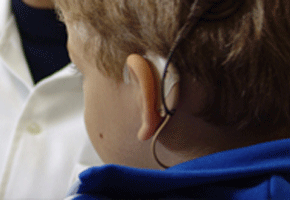

A study reveals that hearing loss is much higher among children with HIV-AIDS, reaching 36% of individuals evaluated
A study reveals that hearing loss is much higher among children with HIV-AIDS, reaching 36% of individuals evaluated
A study reveals that hearing loss is much higher among children with HIV-AIDS, reaching 36% of individuals evaluated

A study reveals that hearing loss is much higher among children with HIV-AIDS, reaching 36% of individuals evaluated
By Fábio de Castro
Agência FAPESP – Hearing loss and suppurative otitis media – an inflammation of the middle ear that can be caused by the use of antiretroviral drugs – occur at high rates among HIV+ children and adolescents, affecting 36% of the individuals evaluated, according to a study conducted by Universidade de São Paulo (USP).
Another study conducted by USP shows that although HIV+ adolescents need to take special care with their diets, they generally have diets similar to adolescents without the disease, consuming high quantities of sugar, saturated fat and sodium while not eating enough whole grains and fruit.
The two studies are part of the “Quality of life and its relation to the lifespan of HIV/Aids children and adolescents” research funded by FAPESP under its Regular-Research Awards and coordinated by professor Maria do Rosário Latorre of USP’s Public Health School (FSP – USP).
The studies on hearing loss and diet were a part of the doctoral thesis of Aline Medreiros da Silva and the master’s dissertation of Luana Tanaka, respectively. Latorre served as the mentor for both projects, which were defended in 2011 at FSP-USP and received FAPESP fellowships. In addition to research, the project generated another doctorate and two ongoing master’s degrees.
According to Latorre, the cohort studies were conducted with HIV+ children served by the Children’s Institute at USP’s Medical School within the Hospital das Clínicas.
“The project has the objective of analyzing the quality of life of HIV+ children and adolescents in relation to health, usage of medicine, presence of lipodystrophy, hearing loss and survival,” Latorre explained in an interview with Agência FAPESP.
Silva, who is a speech therapist, evaluated 106 HIV+ individuals between the ages of 5 and 19 who utilize the services of the Children’s Institute with the objective of estimating the prevalence of hearing loss among patients and identifying the associated factors. In addition to doctoral funding, Silva received fellowships for Scientific Initiation and her master’s.
Two criteria were used to identify hearing loss. The BIAP, an international classification that uses an average of results based on audiometry, is broadly used to diagnose hearing loss. ASHA is a more rigorous criterion that classifies very small changes in hearing loss.
“Even using the BIAP classification, children and adolescents presented a much higher prevalence for hearing loss: 35.8%. Using ASHA, the prevalence was 59.4%. Population-based studies conducted in Brazil showed that among children who are HIV+ or living with AIDS, the prevalence of hearing loss could be between 2% to 20%, depending on the criteria,” explains Silva.
Suppurative otitis media, according to Silva, appears to be a risk factor for hearing loss. The study also found a correlation between hearing loss and the use of the antiretroviral drug lamivudina.
“Children who had suppurative otitis media had a higher prevalence of hearing loss, like those who used lamivudina. Both individuals who presented inflammations and those who used the antiretroviral had a six times higher chance of presenting hearing loss,” she affirmed.
Based on the study’s conclusions, Silva recommends that HIV+ children or those living with AIDS receive long-term medical treatment, with periodic testing for hearing loss.
“These children have very debilitated immunological systems and need special care. Ideally, children using public health facilities would be evaluated every six months with audiometry to monitor their case before hearing loss sets in,” he declared.
In the study on diet, Tanaka utilized data from interviews with 88 HIV+ individuals aged 10 through 19 years who utilize the Children’s Institute. The methodology consisted of applying a Brazilian adaptation of the Quality Diet, which evaluates the consumption of items such as fruit, vegetables, oil, cereal, whole grains, saturated fat, sodium and other components.
“Some things stood out. We found that 72% of adolescents did not eat whole grains. Approximately 86% of those interviewed had high sodium consumption. We also found low averages for the consumption of fruit and calories from solid fats,” said Tanaka.
According to Tanaka, the data indicate that a low-quality diet is consumed, which does not differ from the typical diet of Brazilian adolescents who do not have HIV-AIDS. According to her, the study indicates a need to improve the diets of HIV+ adolescents.
“The international literature shows that antiretroviral therapy could contribute to increased fat in the abdominal region and could be associated with higher bad cholesterol levels. For this reason, many of these adolescents are at greater risk than the uninfected population when they have poor eating habits. Nevertheless, their eating habits are similar,” said Tanaka.
The study, according to Tanaka, suggests that HIV-AIDS treatment should have a broader focus than antiretroviral therapy, accounting for the patient’s quality of life, diet, physical activity, hearing loss and the emergence of opportunistic disease.
Republish
The Agency FAPESP licenses news via Creative Commons (CC-BY-NC-ND) so that they can be republished free of charge and in a simple way by other digital or printed vehicles. Agência FAPESP must be credited as the source of the content being republished and the name of the reporter (if any) must be attributed. Using the HMTL button below allows compliance with these rules, detailed in Digital Republishing Policy FAPESP.




